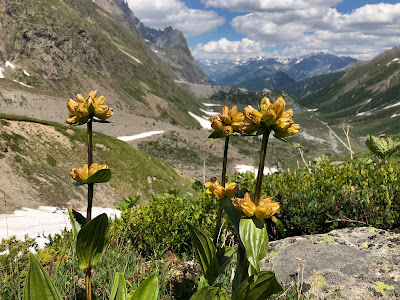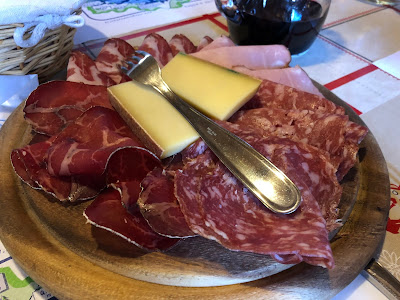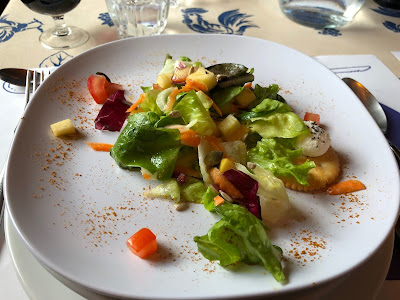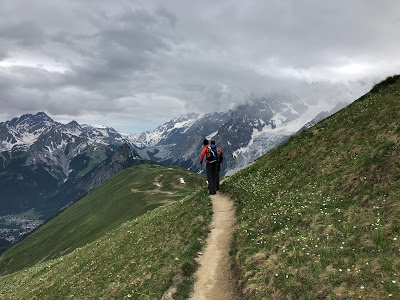



Upper Left: GPS tracks of hike to Rifugio Elisabetta up the Val Veny. Upper Right: A view of Val Veny looking northeast with Spotted Gentian. Lower Left: Lake Comal and view southwest toward Rifugio Elisabetta. Lower Right: Lake Miage and the Miage Glacier.
Overview
Length: 15.2 km (9.4 mi)
Duration: 5.0 hours walking, plus time spend at lunch
at Rifugio Elisabetta
Elevation: 1.681 m (5,515 ft) @ start of hike above
La Visaille; 2.195 m (7,201 ft) @ Rifugio Elisabetta
Location: Italy, Valle d’Aosta, Courmayeur, Val Veny
Details
Last weekend, we dropped a friend off who was starting the Tour du Mont Blanc (TMB) from Courmayeur. See, Hike from Courmayeur to Rifugio Bonatti and Back. This week, we came back to pick her up. She started the hike from Courmayeur going counter-clockwise. We walked with her up the Val Ferret (north of Courmayeur) to Rifugio Bonatti. On today’s hike we met her at Rifugio Elisabetta in Val Veny (sourth of Courmayeur) to walk her back.
This hike is easy to do. From Courmayeur, follow the signs
for Val Veny and keep driving up the road Via Val Veny until you cross a bridge
and you see cars parked on the side of the road (approximately here).
Park and start walking on the asphalt road, which will give way to a dirt road
and then a trail/road all the way to Rifugio Elisabetta Soldini. As far
as trails go, it’s not that interesting, but the scenery makes up for it.
From the rifugio, we caught sight of two herds of alpine
ibex (Capra ibex) – called stambecco in Italian – and one herd of
Chamois (Rupicapra rupicapra).
On the way to or from the Rifugio, make sure you stop to see
Lake Miage. It’s a short climb from the main trail/road first to reach Cabane
du Comba (1.968 m) and then on upward to the lakes. You’ll see some beautiful
blue lakes, but keep walking to see Lake Miage, which is browner in color.
Note the ice cliffs at one end of the lake. They are part of the Miage Glacier, “Italy's longest glacier and also the largest debris-covered glacier in Europe.” [Wikipedia]. The debris gives the lake its brownish color. When we were there, we saw small rocks rolling down the ice cliffs into the water. It was a warm day. On another warm day on August 7, 1996, visitors to the lake saw a little bit more than a rock or two: they saw huge ice blocks calf off the glacier and cause a wave that swept people into the nearby lake as shown in this video. Be careful. For interesting views of Lake Miage over the years, see Glaciers online.
Next to the Rifugio Elisabetta you can view a plaque honoring those lost in the 1946 crash of B-17 above the rifugio at Aiguille des Glaciers. For more information, see the B17 Mont Blanc site.
Flora
We noted two things about this hike in contrast to last week’s hike in Val Ferret. First, we didn’t as many orchids – at least that were easily visible from the trail – as in Val Ferret, and second, in Lago Combal there are a lot of shrubby trees that looked to be part of the willow family, but we couldn’t be sure. Plants we didn’t see in Val Ferret but we did see here in Val Veny were Dryas octopetala and Gentiana punctata.
Usual disclaimer: we use the resources listed in the post Resources
for Identifying Plants around Bergamo to identify plants shown
here, specifically the web sites that allow you to change region. (Set
region to Valle d’Aosta). If we had to give ourselves a score for
identifications, it would be 95% accurate for species and 98% for genus.
Key: [Family] Genus species – Common name in English (Common name in Italian)
[Asteraceae] Crepis
aurea – Golden Hawk's Beard (Radicchiella
aranciata)
[Asteraceae] Petasites
albus and hybridus– Likely based
on emergence of flowers before leaves.
[Asteraceae] Tussilago farfara – Coltsfoot (Tossilaggine comune)
[Ericaceae] Vaccinium vitis-idaea - Foxberry, Ligonberry (Mirtillo rosso)
[Asteraceae] Tussilago farfara – Coltsfoot (Tossilaggine comune)
[Ericaceae] Vaccinium vitis-idaea - Foxberry, Ligonberry (Mirtillo rosso)
[Ericaceae] Rhododendron ferrugineum – Alpenrose
(Rododendro rosso)
[Gentianaceae] Gentiana
punctata – Spotted Gentian (Genziana
punteggiata)
[Geraniaceae] Geranium sylvaticum - Wood Cranesbill (Geranio dei boschi)
[Geraniaceae] Geranium sylvaticum - Wood Cranesbill (Geranio dei boschi)
[Linaceae] Linum spp.
– Blue Flax (Lino)
[Orchidaceae] Nigritella
nigra rhellicani - Vanilla Orchid (Moretta, Vaniglia d’Alpe)
[Primulaceae] Primula
spp. – Possibly P. hirsuta.
[Primulaceae] Soldanella alpina – Alpine Snowbell
(Soldanella comune)
[Ranuculaceae] Aquilegia
alpina – Alpine Columbine (Aquilegia
delle Alpi)
[Ranunculaceae] Caltha
palustris – Water Cowslip (Caltha palustre)
[Rosaceae] Dryas
octopetala – White Dryas (Camedrio
alpino)
[Rosaceae] Rosa spp.
[Rosaceae] Rosa spp.
[Saxifragaceae] Saxifraga oppositifolia –
Purple Mountain Saxifrage (Sassifraga a foglie opposte)
![[Ericaceae] Rhododendron ferrugineum – Alpenrose (Rododendro rosso). [Ericaceae] Rhododendron ferrugineum – Alpenrose (Rododendro rosso).](https://blogger.googleusercontent.com/img/b/R29vZ2xl/AVvXsEjV4fWue4F15cZLkPFnmT3Xatx9gJCRGM0XjCIColU7L4_RuR7VFRzIiltVw9gDPKjqA73hIePjlCodoFaHlNCmYIq2g29rfNSFdFvRbMvwC4-qMkYWaP4fKWO-6tKhpsItpnN6K-HmJQ/s400/Flora+-+%255BEricaceae%255D+Rhododendron+ferrugineum.jpg)
![Gentianaceae] Gentiana punctata – Spotted Gentian (Genziana punteggiata). Gentianaceae] Gentiana punctata – Spotted Gentian (Genziana punteggiata).](https://blogger.googleusercontent.com/img/b/R29vZ2xl/AVvXsEjOgV-PzNr9_DCinZY0OrDxsyvvPPweIufFObQNdtyMOJnKWeW8FG81rC5lY1qt700346myn8hG0IS4nTniOF24vWaRkvPT_YnZuyMotnO8YZJbji1QwId7wPjcXt9mkDH41bk8pasr2g/s400/Flora+-+%255BGentianaceae%255D+Gentiana+punctata+%25281%2529.jpg)
![[Asteraceae] Crepis aurea – Golden Hawk's Beard (Radicchiella aranciata). [Asteraceae] Crepis aurea – Golden Hawk's Beard (Radicchiella aranciata).](https://blogger.googleusercontent.com/img/b/R29vZ2xl/AVvXsEiYo7ZuNwpO4O-fburHBVyLGNoBai1AYd_sRDaa90tzrWTbb4mrc0rR3EyxF_39hLYzZ2IP4EBjgPvgu6KI5t1zk0RrywpAHZeFd287Hs-jfSWLi0gJQrESgpvLxOck42Gfg5qH5zKH5Q/s400/Flora+-+%255BAsteraceae%255D+Crepis+aurea.jpg)
Left: [Ericaceae] Rhododendron ferrugineum – Alpenrose (Rododendro rosso). Center: [Gentianaceae] Gentiana punctata – Spotted Gentian (Genziana punteggiata). Right: [Asteraceae] Crepis aurea – Golden Hawk's Beard (Radicchiella aranciata).
![[Linaceae] Linum spp. – Blue Flax (Lino). [Linaceae] Linum spp. – Blue Flax (Lino).](https://blogger.googleusercontent.com/img/b/R29vZ2xl/AVvXsEi2jq9HS88LMb3itq2qid9lblybW0LKtqvvTLu8hXJgMwmGhH2h-6opoiKfu_6D_vXJ5Oo7kav1UyRV4Pu0wSiCKjQTSsM65nQ_ZrrCfncQejdNM5HBHnDo_UxzkCuXGRT93rW7Uv2Lig/s400/Flora+-+%255BLinaceae%255D+Linum+spp.jpg)
![[Primulaceae] Primula spp. – Possibly P. hirsuta. [Primulaceae] Primula spp. – Possibly P. hirsuta.](https://blogger.googleusercontent.com/img/b/R29vZ2xl/AVvXsEhCNU_cXCiIOWXh5Vknr1vR_w6UtkBoBoAusYnPMkLsjunHvOpOFa604ILQ0Tx-Mex5pu2PqzrfxgFxr5xFgAEciGMDQGMFX27xulE_xmJ69M6Fiqa3S6IbLumrU0qULQm9-U13SOJFIQ/s400/Flora+-+%255BPrimulaceae%255D+Primula+spp.jpg)
![[Orchidaceae] Nigritella nigra rhellicani - Vanilla Orchid (Moretta, Vaniglia d’Alpe). [Orchidaceae] Nigritella nigra rhellicani - Vanilla Orchid (Moretta, Vaniglia d’Alpe).](https://blogger.googleusercontent.com/img/b/R29vZ2xl/AVvXsEh7jG2l6NH1Y1D5Nes6VPNu8tV13OzZz0gLHubsuUUfYPQtK783V1jTgt3_LtutcgLHm1s08MAGvAdxtyAhYr1mMzI8tWq0mYktzcamaFa-ixu9o8anyLi0Xj9yCXD0K_Zo1gHlUWl-Ig/s400/Flora+-+%255BOrchidaceae%255D+Nigritella+nigra+rhellicani.jpg)
Left: [Linaceae] Linum spp. – Blue Flax (Lino). Center: [Primulaceae] Primula spp. – Possibly P. hirsuta. Right: [Orchidaceae] Nigritella nigra rhellicani - Vanilla Orchid (Moretta, Vaniglia d’Alpe).
![[Ranunculaceae] Caltha palustris – Water Cowslip (Caltha palustre). [Ranunculaceae] Caltha palustris – Water Cowslip (Caltha palustre).](https://blogger.googleusercontent.com/img/b/R29vZ2xl/AVvXsEgeGUEtcWiSamTLzn9lrC5BtdEiDKWq626dZWJZGzCdG61qksXqBgPYyLoLc155is6xvvJFmE5bFzUSYFVxW0O4ZbFrFlEi245DC626nPPuGbPy2x7CFIRK6DUBiayBsiEh8-NKQe1NnA/s400/Flora+-+%255BRanunculaceae%255D+Caltha+palustris.jpg)
![[Rosaceae] Dryas octopetala – White Dryas (Camedrio alpino). [Rosaceae] Dryas octopetala – White Dryas (Camedrio alpino).](https://blogger.googleusercontent.com/img/b/R29vZ2xl/AVvXsEi-Mafdrpr5CLFrFp7Sxg-3FWhll16X2YPyPD3j0_H4wQqjPtgR1mNKlRoQsqzkXeDa6n-7FUTyMm7tcjq1hHqQHQ4fTFcFlHmjOEdasVr0WfRnzEWZwkJKULfG40EEuqtmxTzcep4OLA/s400/Flora+-+%255BRosaceae%255D+Dryas+octopetala.jpg)
![Saxifragaceae] Saxifraga oppositifolia – Purple Mountain Saxifrage (Sassifraga a foglie opposte). Saxifragaceae] Saxifraga oppositifolia – Purple Mountain Saxifrage (Sassifraga a foglie opposte).](https://blogger.googleusercontent.com/img/b/R29vZ2xl/AVvXsEiZ_iMwP5eYRI8CFXUPdmmeAV0a1qQg7M3MWH4fWVZDu0xTYlrxcGYN91VsX9oBDHVbpuryib9DrDsuXskxGUfnGybwg1a42Xj9D9tRCX5EPwSpZLfzIJO1FyRV4a_WKxxnNjDdwwaNCg/s400/Flora+-+%255BSaxifragaceae%255D+Saxifraga+oppositifolia.jpg)
Left: [Ranunculaceae] Caltha palustris – Water Cowslip (Caltha palustre). Center: [Rosaceae] Dryas octopetala – White Dryas (Camedrio alpino). Right: [Saxifragaceae] Saxifraga oppositifolia – Purple Mountain Saxifrage (Sassifraga a foglie opposte).



Left: Polenta concia (infused with Fontina cheese) at Rifugio Elisabetta. Center: Tagliere misto at Rifugio Elisabetta. Right: Approaching Rifugio Elisabetta.


Brochure of the Tour du Mont Blanc (TMB).


Map of Courmayeur.


Left: View of Cabane du Combal, with Lake Combal in front. Right: Looking northeast along Val Veny.



Left: Ettore, the French Bulldog (Bulldog francese) with a stick. Center: Rifugio Elisabetta with the Lex Blanche glacier behind it. Right: View from Val Veny to Grandes Jorasses.
Flower Close-Ups
Now for a little flower porn...
![[Asteraceae] Tussilago farfara – Coltsfoot (Tossilaggine comune). [Asteraceae] Tussilago farfara – Coltsfoot (Tossilaggine comune).](https://blogger.googleusercontent.com/img/b/R29vZ2xl/AVvXsEjAqMZU_3up1eDWmOmnQSRTJo6ylcNMbStRe9_DP1ySlI2XzKaAjQ7mL3NGwn3bPx3FFsE4eFinZwbJu-q915dnVVD5W_O3BJFzorvsoFigzLm2uKoxCBHYTxDIp___8ztb8bsZQECZlA/s280/Flora+-+%255BAsteraceae%255D+Tussilago+farfara.JPG)
![[Gentianaceae] Gentiana punctata – Spotted Gentian (Genziana punteggiata). [Gentianaceae] Gentiana punctata – Spotted Gentian (Genziana punteggiata).](https://blogger.googleusercontent.com/img/b/R29vZ2xl/AVvXsEgk-BU-SQJrIYVY0QjaOkgXhyW8MduOT6dcH4dl3GZ4jenCOej7OAnYQkk2eRN-p4JIfE2yAjTBrVJek0eDXbu2r2LhX2dqXgkiYJsVIu4Tk8vQkmCAsxgJUpBzMQaLtzHe54zY21KV_g/s280/Flora+-+%255BGentianaceae%255D+Gentiana+punctata.JPG)
Left: [Asteraceae] Tussilago farfara – Coltsfoot (Tossilaggine comune). Right: [Gentianaceae] Gentiana punctata – Spotted Gentian (Genziana punteggiata).
![[Geraniaceae] Geranium sylvaticum - Wood Cranesbill (Geranio dei boschi). [Geraniaceae] Geranium sylvaticum - Wood Cranesbill (Geranio dei boschi).](https://blogger.googleusercontent.com/img/b/R29vZ2xl/AVvXsEgtDLz2xH9bJc8S3Ai8kyheUGbc-ujgYRolUYOwkFRN_Q0XqyHuPgVUa7QQnRc0Eje-CGXwgsAiosAEJ-Vvn-XBOP2l95m2l6EKvKe1pFYIM4x7eso7k5ICxNkk3Lv1-foT5MeRaQDvCQ/s280/Flora+-+%255BGeraniaceae%255DGeranium+sylvaticum+2.JPG)
![[Linaceae] Linum spp. – Blue Flax (Lino). [Linaceae] Linum spp. – Blue Flax (Lino).](https://blogger.googleusercontent.com/img/b/R29vZ2xl/AVvXsEhmJLpHNqS0Y2YX_LnJt6k6go9tYFP2vQlabiTX6BBAMkIz9WdmqIqS2qD7PUIco52635-ogYxw2_nEmIL-XIcrNmIi96uX89G8fgZTCzWzaevMuDPh9KRZNcIUpxN-XgqUlktxRjHeGg/s280/Flora+-+%255BLiaaceae%255D+Linum+spp.JPG)
Left: [Geraniaceae] Geranium sylvaticum - Wood Cranesbill (Geranio dei boschi). Right: [Linaceae] Linum spp. – Blue Flax (Lino).
![[Orchidaceae] Nigritella nigra rhellicani - Vanilla Orchid (Moretta, Vaniglia d’Alpe). [Orchidaceae] Nigritella nigra rhellicani - Vanilla Orchid (Moretta, Vaniglia d’Alpe).](https://blogger.googleusercontent.com/img/b/R29vZ2xl/AVvXsEjI62FKo_YaLihbxeZEKaD7Cczo7BR5ofF1UUjqv3EmesOZJ-bTmZ48YDCPTXio-_l60XY0RwAIgi4fKjofwGBghf1F8vWZitU5xiC5UbV7KVhgiS0cIrGvdB7O0Gzk9I9Td8gHU7eYrg/s280/Flora+-+%255BOrchidaceae%255D+Nigritella+nigra+rhellicani.JPG)
![[Ericaceae] Vaccinium vitis-idaea - Foxberry, Ligonberry (Mirtillo rosso). [Ericaceae] Vaccinium vitis-idaea - Foxberry, Ligonberry (Mirtillo rosso).](https://blogger.googleusercontent.com/img/b/R29vZ2xl/AVvXsEjc74QSf5vfZ4-4RFYzoCxov_-kKl4wMTJRYMZ9NsmVulgiIZp2bGhN8ePdJHQpzsm0HWZAVI8XK24P3VFXbFxYSiLkGai3_OrxURXUxkaoCJtZGXy4rCbKbD_vXZdcEeebRsDLdB9-gg/s280/IMG_2797.JPG)
Left: [Orchidaceae] Nigritella nigra rhellicani - Vanilla Orchid (Moretta, Vaniglia d’Alpe). Right: [Ericaceae] Vaccinium vitis-idaea - Foxberry, Ligonberry (Mirtillo rosso).
![[Primulaceae] Soldanella alpina – Alpine Snowbell (Soldanella comune). [Primulaceae] Soldanella alpina – Alpine Snowbell (Soldanella comune).](https://blogger.googleusercontent.com/img/b/R29vZ2xl/AVvXsEh7FFTYk2Gi-7K4hWFY3UuGPtz4fgrNFqtytpA-dRArxzTWxFR9wTN5fbN0PZhJuw6z9UcOjifOd0MGGVfnQCNrcMGgad9NAeUpSbus_IprpG0w6y6aoGMlFXkwcabottDAeSc_vxjoOg/s280/Flora+-+%255BPrimulaceae%255D+Soldanella+alpina+2.JPG)
![[Primulaceae] Soldanella alpina – Alpine Snowbell (Soldanella comune). [Primulaceae] Soldanella alpina – Alpine Snowbell (Soldanella comune).](https://blogger.googleusercontent.com/img/b/R29vZ2xl/AVvXsEgoWT-Stx3glsblwz99WSXE6PMmXPPUhbePt8DA2LuuPRJiC-_-obtpmqFY29VtK_s0vEaQOF3VvXHdLfxm8WEeHmnHy9YgykMARiqw3F_xOYsUjqAQfEyrwVOO-aTmTIya21A7FTQUlA/s280/Flora+-+%255BPrimulaceae%255D+Soldanella+alpina.JPG)
[Primulaceae] Soldanella alpina – Alpine Snowbell (Soldanella comune).
![[Ranuculaceae] Aquilegia alpina – Alpine Columbine (Aquilegia delle Alpi). [Ranuculaceae] Aquilegia alpina – Alpine Columbine (Aquilegia delle Alpi).](https://blogger.googleusercontent.com/img/b/R29vZ2xl/AVvXsEgkZLs6u0OabaxI_94bW5iZGBmW7wYPAcJQynQm7Rp5y2GtDIFX-oHjAFWcQolo-210C5jfISjIW__Oj2sGyp4QDHevlzSq03ELxhhyxldXsw4YuG4dvzor8m4aTBjoK4lc7Bk4i50Fjg/s280/Flora+-+%255BRanuculaceae%255D+Aquilegia+alpina.JPG)
![[Rosaceae] Rosa spp. [Rosaceae] Rosa spp.](https://blogger.googleusercontent.com/img/b/R29vZ2xl/AVvXsEjsuInnWFB8b6BQgtWWYNObRh-2ie6gUypDZ__t6KGSTW-0DiS_r08vDysjZvmUH8X30IVmRzxgj6FXCi_j1H_WOcl9CPObN_ST0DBgXUFy6gPcZ59kNRpDk_yTGuXREBP6jXpAl6HqUw/s280/Flora+-+%255BRosaceae%255D+Rosa+spp..JPG)
Left: [Ranuculaceae] Aquilegia alpina – Alpine Columbine (Aquilegia delle Alpi). Right: [Rosaceae] Rosa spp.


![[Ranunculaceae] Thalictrum aquilegifolium – Columbine Mead-Rue (Pigamo colombino). [Ranunculaceae] Thalictrum aquilegifolium – Columbine Mead-Rue (Pigamo colombino).](https://blogger.googleusercontent.com/img/b/R29vZ2xl/AVvXsEh1LjnKU8is1JLWBhBfNGhCCJAIP8maZirfXP90qeuq_vHbdi5ATONVJDIKv7PKDo5LX2Y4kmlmwjmuB1ntHphK2V2gNZRMrWeCYScouV4ka_-6NEig2XyoccMibtfajfzlNQC42KL2jg/s280/Flora+-+%255BRanunculaceae%255D+Thalictrum+aquilegifolium.jpg)

![[Asparagaceae] Anthericum liliago – St Bernard’s Lily (Lilioasfodelo maggiore). [Asparagaceae] Anthericum liliago – St Bernard’s Lily (Lilioasfodelo maggiore).](https://blogger.googleusercontent.com/img/b/R29vZ2xl/AVvXsEiU4iRz9ypDWEsSkVolnh73jCm0p6t0qD7iyE4iBYQxzKa8GubMFDfg0DoLGhe2xC9vqabcAB6uTzb1GtDA9qfD_S4QbRt1b0pkIhumA0qtYBBD2OE3rYJyQqHEqOosNV-Ii-98gO8ojg/s400/Flora+-+%255BAsparagaceae%255D+Anthericum+liliago+%25281%2529.jpg)
![[Asparagaceae] Anthericum liliago – St Bernard’s Lily (Lilioasfodelo maggiore). [Asparagaceae] Anthericum liliago – St Bernard’s Lily (Lilioasfodelo maggiore).](https://blogger.googleusercontent.com/img/b/R29vZ2xl/AVvXsEjG2CGfxATSXTEv8oFm2uQYrtuoQdlGcfXS2_OS39JxCy3BsegihRpt9l11GWctgxTfRonfgte0CHDjO874qetpbXYh2g_4MvoVUPAV1RUcyt3SxNjR_NtWa-cclbDfW-ccjHVXNKeIsg/s400/Flora+-+%255BAsparagaceae%255D+Anthericum+liliago+%25282%2529.jpg)
![[Saxifragaceae] Saxifraga oppositifolia – Purple Mountain Saxifrage (Sassifraga a foglie opposte). [Saxifragaceae] Saxifraga oppositifolia – Purple Mountain Saxifrage (Sassifraga a foglie opposte).](https://blogger.googleusercontent.com/img/b/R29vZ2xl/AVvXsEgVwF2MULi-sKMTeJr0vosUYErF6Z4FmDLJIo7Fp9JCuwK7mFeuAcbBF03YfJB_urz9qEtup24Pz84YQ8xe8UD0O-JJPKbXXp65zAhyphenhyphenDAVp_YPm8uO086u4011cf8j9_J0iX4tqPK8xMA/s400/Flora+-+%255BSaxifragaceae%255D+Saxifraga+oppositifolia.jpg)
![[Ranunculaceae] Pulsatilla spp. – possibly P. montana. [Ranunculaceae] Pulsatilla spp. – possibly P. montana.](https://blogger.googleusercontent.com/img/b/R29vZ2xl/AVvXsEgSh692Ez925J-TwcqH1Zi7k3UHwCILpOl7FgB1xMDToQgIGzhgbJh4uauK-uUzZGU_HpUeiza2wAMuHNH5VOnd1dN3mRgBN14OfXyBDEBQQl8BNhSiyNulFEct7AODwPKPr0qk3a3nyA/s400/Flora+-+%255BRanunculaceae%255D+Pulsatilla.jpg)
![[Asteraceae] Adenostyles spp., possibly P. alpinus based on bloom time and elevation distribution. [Asteraceae] Adenostyles spp., possibly P. alpinus based on bloom time and elevation distribution.](https://blogger.googleusercontent.com/img/b/R29vZ2xl/AVvXsEhnoD6FGjf5jdGV_9vB5ifmL5-Sg_Lu9tD4AYDsFobjxxdLSln0Wl3cQBq1rawe6TGFwxmltLKjsa21rFrQ2K9NbVvpXKGwydaE1HAxLN3gU2b_s9FAv7lnJvE4Xzjb6mqiopSgd930hQ/s400/Flora+-+%255BAsteraceae%255D+Adenostyles+spp.jpg)
![[Asteraceae] Petasites spp., possibly P. hybridus based on purple brown flower stalks. [Asteraceae] Petasites spp., possibly P. hybridus based on purple brown flower stalks.](https://blogger.googleusercontent.com/img/b/R29vZ2xl/AVvXsEg2J4S83EJKCAzVMv7R2UPcIKrEEx1Sm6tDDXCMizW90whre5seFFxRr4PIXAis7yhYUMvPta_Ig4LeyfXaEJZHDLX1b5wWCkoYi7LqRA6IobxL7dvS93DGFkhme8YKQ2GFE5ych8Zozg/s400/Flora+-+%255BAsteraceae%255D+Petasites+spp.jpg)
![[Ericaceae] Rhododendron ferrugineum - Alpenrose (Rododendro rosso). [Ericaceae] Rhododendron ferrugineum - Alpenrose (Rododendro rosso).](https://blogger.googleusercontent.com/img/b/R29vZ2xl/AVvXsEiPS-CwHIt6cmdHn3IepsdhwjUqFC4wPhWZwb4SNS35dJAyH5uqm_rt5_Kp_11vKvCYQjyFvXYIgYT5hIiiGcEHEK4GdyLxhnWZv3psjuJrXc3-xwkgXyGE6a-ckZ_53u67PUFnIxXh0A/s400/Flora+-+%255BEricaceae%255D+Rhododendron+ferrugineum.jpg)
![[Asteraceae] Tussilago farfara – Coltsfoot (Tossilaggine comune). [Asteraceae] Tussilago farfara – Coltsfoot (Tossilaggine comune).](https://blogger.googleusercontent.com/img/b/R29vZ2xl/AVvXsEiENxtKV5RZgzFZmrOi4tdj-nO6yCsdPUmKqqdtYjST6xeESUo-Hcsstkn_aB0jnjueF7eE7BEnO-CdoAwthf-Y_3zCxtFclPO9xAbk9NSKGQ5hGry-0ehPbCydVbtBOutG0huPxnyoHA/s400/Flora+-+%255BAsteraceae%255D+Tussilago+farfara.jpg)
![[Berberidaceae] Berbis vulgaris – Common Barberry (Crespino comune). [Berberidaceae] Berbis vulgaris – Common Barberry (Crespino comune).](https://blogger.googleusercontent.com/img/b/R29vZ2xl/AVvXsEiL3SevQR5ISov875p4f9zmcVTVXCksm4nB-_9WeUM8ktqCqXAIUky7p5whw0hG9ijzR2VJkTrHcULgdBoOVtlg47uIkfMO1JLf9DkcJTSkr9fnQWajc2nLG-l2qnWcuTDf97ItluC3Fg/s400/Flora+-+%255BBerberidaceae%255D+Berbis+vulgaris.jpg)
![[Brassicaceae] Huguennia tanacetifolia – Tansy-Leaved Rocket (Luppolo del Giappone a foglie di tanaceto). [Brassicaceae] Huguennia tanacetifolia – Tansy-Leaved Rocket (Luppolo del Giappone a foglie di tanaceto).](https://blogger.googleusercontent.com/img/b/R29vZ2xl/AVvXsEhgHbF84qBzAh6ZtqXcUiJjBfJJOcYP64D4FqfL9afBiskHNtL8Z6GRVmrMr04OTZ21F7QYSli7m2Rr2PmLIQhc849I9CbzDvvPCQe9TSvfnjIewUTXX88ySIt-mutYoakB5nDfkg59rw/s400/Flora+-+%255BBrassicaceae%255D+Huguennia+tanacetifolia.jpg)
![Left: [Brassicaceae] Draba aizoides – Yellow Whitlow Grass (Draba aizoide). Left: [Brassicaceae] Draba aizoides – Yellow Whitlow Grass (Draba aizoide).](https://blogger.googleusercontent.com/img/b/R29vZ2xl/AVvXsEiDNs2jowDPRHb4bxKRQNEzbecmPyFmwhqs6LHCCRUqTmrPknTCobziZSL8D3HqxgrrQcIaCJJxjmu1e_xcRXACFD25yrloLKGTC-J3uLEkkrOV0i6nxTZt2jYnA50rCRA3gSCGU_kOTA/s400/Flora+-+%255BBrassicaceae%255D+Draba+aizoides.jpg)
![[Ranunculaceae] Trollius europeaus – Globeflower (Botton d’oro). [Ranunculaceae] Trollius europeaus – Globeflower (Botton d’oro).](https://blogger.googleusercontent.com/img/b/R29vZ2xl/AVvXsEgo9QhF_PHFBJGk0meqAP5cOad9kLuOvj_2UkMjyGYKnGxiPYySMmdOqKKrdYrhgC_MxhG-kbtch4RLu42zuLqrs9qDPINeUQiRRG3pSS3PkGHcCgxPU9-D0OVWE2qG74ZrhyphenhyphenowYYigPw/s400/Flora+-+%255BRanunculaceae%255D+Trollius+europeaus.jpg)
![[Ranunculaceae] Caltha palustris – Water Cowslip (Caltha palustre). [Ranunculaceae] Caltha palustris – Water Cowslip (Caltha palustre).](https://blogger.googleusercontent.com/img/b/R29vZ2xl/AVvXsEhY1sqaO119HMwFW22r_LgUjIp0_5PeluMPvDC0dBDipV45aZPphFwDamAMSt9i10r3tRxcOXlhnG8i8a-mqFqxm6-nQhgdJLmwwNAIPSlPNOjr3pElumlOU81hsBSJ68uynlXEnGwjTQ/s400/Flora+-+%255BRanunculaceae%255D+Caltha+palustris.jpg)
![Left: [Fabaceae] Onobrychis montana – Mountain Sainfoin (Lupinella montana). Left: [Fabaceae] Onobrychis montana – Mountain Sainfoin (Lupinella montana).](https://blogger.googleusercontent.com/img/b/R29vZ2xl/AVvXsEjrLFF63a2QEpKRlY_4XkP1qQUxk5MMqKQ5UDqOY0YBZJLaiTIZqM4exLFYQvgi-37pYgIiyfYWnBalP-SD3tJguGxhpJ-UlTIcmFVBfXUXIpazux7PERvszs-g8xrbhkIpPNzOZceAsg/s400/Flora+-+%255BFabaceae%255D+Onobrychis+montana.jpg)
![[Orobanchaceae] Pedicularis verticilla – Whorled Lousewort (Pedicolare a foglie verticillate). [Orobanchaceae] Pedicularis verticilla – Whorled Lousewort (Pedicolare a foglie verticillate).](https://blogger.googleusercontent.com/img/b/R29vZ2xl/AVvXsEhMt9J2TVpX2T-eqBgnW0wVTvgW5BW6vEQexz3Ws4o-ygxqOKqDDoCWcBlfoiUu2lXb7jEAcUvSrobYEtlXKUREd7pxiJqU6jRyMK1k3GbTTIZlatZg8KJB5OqQvAfm55VY7nb5QqHwVQ/s400/Flora+-+%255BOrobanchaceae%255D+Pedicularis+verticilla.jpg)
![[Boraginaceae] Echium vulgare – Viper’s Burgloss (Viperina azzurra comune) [Boraginaceae] Echium vulgare – Viper’s Burgloss (Viperina azzurra comune)](https://blogger.googleusercontent.com/img/b/R29vZ2xl/AVvXsEhzN3a1kUacoxxCjgIzYq1dH8s6-zhyphenhyphen7kHHTEgX6LD-ApBVBpTLezcT0hsOB14K8QiWgzwNywp41DbQtpNgTX0LHzTnN_ZrDO1Mr7p3YBW7-Fi_oTaRxUNuCMOWY-f0slJ9ov6gac5RBQ/s400/Flora+-+%255BBoraginaceae%255D+Echium+vulgare.jpg)
![[Gentianaceae] Gentiana acaulis – Stemless Gentian (Genziana acaule), based on green inside of flower. [Gentianaceae] Gentiana acaulis – Stemless Gentian (Genziana acaule), based on green inside of flower.](https://blogger.googleusercontent.com/img/b/R29vZ2xl/AVvXsEjDDNx0IW_F2l5dDbnPphQzOK5R_AfPCbWcKK4Iwe8bawXDkRdk6RJHtG7ee1GSfs4tqM22bTjlEl0hdwYfURTTy1loLVUt3BaHocp84vOIpVJ09ErGWKr6X2pwmdp9duQofyeUEvnoFA/s400/Flora+-+%255BGentianaceae%255D+Gentiana+acaulis.jpg)
![[Gentianaceae] Gentiana verna – Spring Gentian (Genziana primaverile). [Gentianaceae] Gentiana verna – Spring Gentian (Genziana primaverile).](https://blogger.googleusercontent.com/img/b/R29vZ2xl/AVvXsEgdUjuE9pnQg3-a2DyeiFCZ4U4XiH9KbSdIAb8ltHiw9B3r7q61gpFSYt89uaQgxhHOaFg8ZCfZptylZWYCKcSjs0p5EhVtN2QbU6WyTm0bTq77I73uMGox0Ll0qmMtTRGKUKXWqeXCZg/s400/Flora+-+%255BGentianaceae%255D+Gentiana+verna.jpg)
![[Orobanchaceae] Bartisa alpina – Velvet Bells (Bartsia delle Alpi). [Orobanchaceae] Bartisa alpina – Velvet Bells (Bartsia delle Alpi).](https://blogger.googleusercontent.com/img/b/R29vZ2xl/AVvXsEg9w2rOewmiba4dTTlP0iI5jpBhzPIt05lVtab1WiiX1QNNQAe7wDi0zG-_CZZG9NSDpy_XhwsN7q4TIW1KDGBiGSqy8QCm9i-hTaYWBLiJjas_s1fh4ZLoj9_iq6lcuFAnNuEJwOC4Vw/s400/Flora+-+%255BOrobanchaceae%255D+Bartisa+alpina.jpg)
![[Plantaginaceae] Linaria alpina – Alpine Toadflax (Linajola alpina). [Plantaginaceae] Linaria alpina – Alpine Toadflax (Linajola alpina).](https://blogger.googleusercontent.com/img/b/R29vZ2xl/AVvXsEg0PHpBNCnm6qiW6AWBuCpoDiE9IjHpMn3MiV-qNhGbkwaT5iMwlOjz3cc2Km5gj8uTBaO-dbH99UxgHNFbntZpBt9gDQer7zi1uL6S-7tLLKRV1M9M1dcGVdKqbvs3Fo_42w4CDk4O3Q/s400/Flora+-+%255BPlantaginaceae%255D+Linaria+alpina.jpg)
![[Melanthaiaceae] Veratrum album – White Hellebore (Veratro bianco). [Melanthaiaceae] Veratrum album – White Hellebore (Veratro bianco).](https://blogger.googleusercontent.com/img/b/R29vZ2xl/AVvXsEjFFM9it6vOoOMlwrTGlNRuiKDXZ9SyJ4Fp5kOsuh_gnCEpZj9ylOCnv4nGrUT2BRBnaceRKHLo0qqrLlFaO8OttfwWdArJj0qbAjdCO1I8GTrXkPF4OXzxYxVe8GN1PL60t1ABFgR3ng/s400/Flora+-+%255BLamiaceae%255D+Stachys+recta.jpg)
![[Melanthaiaceae] Veratrum album – White Hellebore (Veratro bianco). [Melanthaiaceae] Veratrum album – White Hellebore (Veratro bianco).](https://blogger.googleusercontent.com/img/b/R29vZ2xl/AVvXsEij-KTCnM2aWMGNgnUlJ-V0f_JqVphRb5eIDluxUZI0XM4p5pzIbwwNLH2Dtuk1_2QLqvWu7cJWerxUqj26jfpJi1oYf9Z8DFPufRb9V_G2GIVQqW1Ab5gqHB0MBhMJtqdU613aMTsW4Q/s400/Flora+-+%255BMelanthaiaceae%255D+Veratrum+album.jpg)
![[Primulaceae] Soldanella alpina – Alpine Snowbell (Soldanella comune). [Primulaceae] Soldanella alpina – Alpine Snowbell (Soldanella comune).](https://blogger.googleusercontent.com/img/b/R29vZ2xl/AVvXsEifxabHd2vlvTSrzteXqf1CwYXiXnL3RZXbgexoYbubu_WnwH9I9afe65Srwt00oM2iBF9zyn-zF0-2NBPrV3k2eB6EYai9esPE88z8j24MmnNuTkSPda2lndpcXLzSiU_e4FbgYaxfKw/s400/Flora+-+%255BPrimulaceae%255D+Soldanella+alpina+2.jpg)
![[Primulaceae] Soldanella alpina – Alpine Snowbell (Soldanella comune). [Primulaceae] Soldanella alpina – Alpine Snowbell (Soldanella comune).](https://blogger.googleusercontent.com/img/b/R29vZ2xl/AVvXsEhIb4oVXYj6q-WwdTEhsXHbheRTO4-z5HieC9CS5kduIXo6bXdZhNBiLtDmDKryEiwp7y7Zb4sbmRE9V0c_acPH395qrOzW3Nrq1i2x-gBkCEkPKZ5yWxW8NbrFfVxKDSO9IxPJQ-b50Q/s400/Flora+-+%255BPrimulaceae%255D+Soldanella+alpina.jpg)
![[Orchidaceae] Dactylorhiza sambucina – Elder-flower Orchid (Orchide sambucina). [Orchidaceae] Dactylorhiza sambucina – Elder-flower Orchid (Orchide sambucina).](https://blogger.googleusercontent.com/img/b/R29vZ2xl/AVvXsEjjMTzPJw-kfNVaSb4qTo470WEKWtwOZdneer6hdl6ynO2NBQXyfwJOOxxTP67_Wns9fv3WjBy5OBAhJIakcVVJmC6xibx_8dt9pkbLYL8Y631nwWC6p0cbUm1_bIE_gPQTCqJI2cSHwg/s400/Flora+-+%255BOrchidaceae%255D+Dactylorhiza+sambucina+%25281%2529.jpg)
![[Orchidaceae] Dactylorhiza sambucina – Elder-flower Orchid (Orchide sambucina). [Orchidaceae] Dactylorhiza sambucina – Elder-flower Orchid (Orchide sambucina).](https://blogger.googleusercontent.com/img/b/R29vZ2xl/AVvXsEh7EN-vK6oHk6y59kMtdhXgwsZEFSHlJf0oauR1jPojOvuTEwjPb1wS9hIC8Djzwpd_1vo_5OaCmowRw1FmoftLxSznl8ly7ILDdztfxy7x4x-KXRGqs36vfEjKB0mZXMN7vWQSlWFdWg/s400/Flora+-+%255BOrchidaceae%255D+Dactylorhiza+sambucina+%25282%2529.jpg)
![[Orchidaceae] Gymnadenia conopsea - Fragrant Orchid (Manina rosea). [Orchidaceae] Gymnadenia conopsea - Fragrant Orchid (Manina rosea).](https://blogger.googleusercontent.com/img/b/R29vZ2xl/AVvXsEgmBNV3WbWgFXZ4O3uGzI7jQJhYtzzQLAZpPlH1aRrCOILK5QJyI9eyedpVlxWrkjgyPzSKj9x5JqF405xnN7PlJdiIw9Gl3mKqkeNCbsqToisif7MgZpoTEj3Puv8KStZ5EP3dxFzQBA/s400/Flora+-+%255BOrchidaceae%255D+Gymnadenia+conopsea.jpg)
![[Plantaginaceae] Plantago media – Hoary Plantain (Piantaggine media). [Plantaginaceae] Plantago media – Hoary Plantain (Piantaggine media).](https://blogger.googleusercontent.com/img/b/R29vZ2xl/AVvXsEjLS3u5R4Uz-wzMiJwGTMJqZepezuuQcRL8X_uaLiksWoSwAbxyD4goy1ZT0U-_kph2b0l_s24-o8xUbakN6r4U31Ys4OF95QFWJ_BqLjuR0zcHVteuCEO7HW13QXUN1ukgxvoo9LPP-A/s400/Flora+-+%255BPlantaginaceae%255D+Plantago+media.jpg)
![[Plantaginaceae] Plantago alpina – Alpine Plantain (Piantaggine delle Alpi). [Plantaginaceae] Plantago alpina – Alpine Plantain (Piantaggine delle Alpi).](https://blogger.googleusercontent.com/img/b/R29vZ2xl/AVvXsEjDlsR9gGR3U5JtIkIohbYD0aYC1XCTmHl79fJupgKESUfDUIPFTN1mvU1ZOa6PFOwAKIgrOIzrJ5CHdmfA9OiyPxlNAkFyCAk9Izpg9IhmQvBcq3EGbNC0i4rPp1FUKQo-h_x3j2SF7w/s400/Flora+-+%255BPlantaginaceae%255D+Plantago+alpina.jpg)
![[Plantaginaceae] Plantago atrata – Dark Plantain (Piantaggine nerastra). [Plantaginaceae] Plantago atrata – Dark Plantain (Piantaggine nerastra).](https://blogger.googleusercontent.com/img/b/R29vZ2xl/AVvXsEiNhh5bcLkOyeWViSqX5RZEth-rX3CJr8HRNvNTtRf6M_80OFgZ-kzgBRZC8LSPaQPx9Q15KDNO9H5RbOORE6xRs6Y_S9w6vMWugz58jC7EtESWYbtAcs7V4DRm0ePp6ZrHdT8mhZLmuw/s400/Flora+-+%255BPlantaginaceae%255D+Plantago+atrata.jpg)














